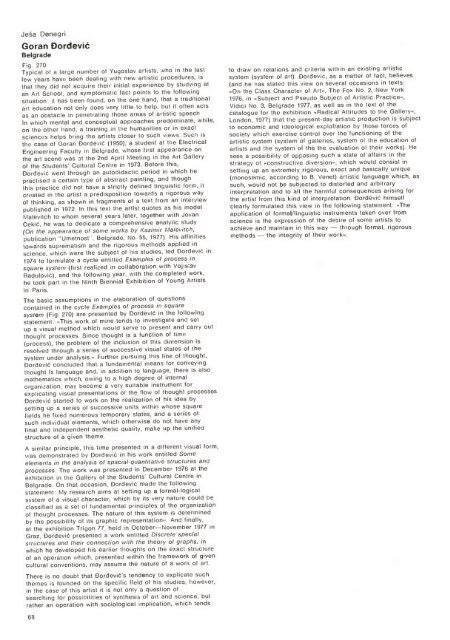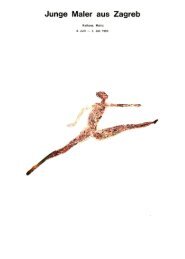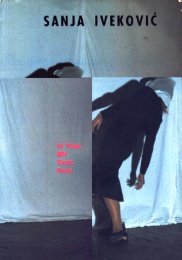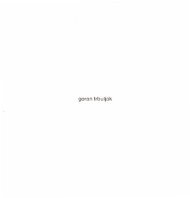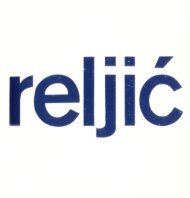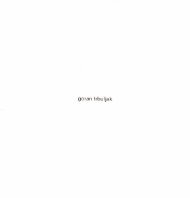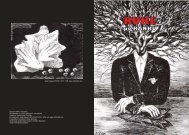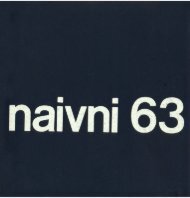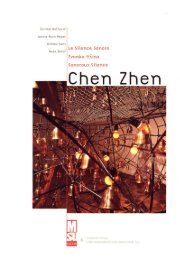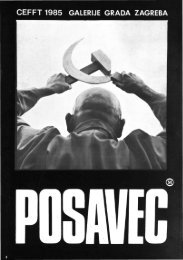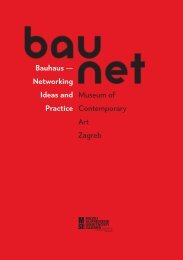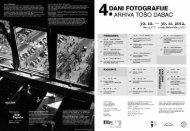The New Art Practice in Yugoslavia, 1966-1978
The New Art Practice in Yugoslavia, 1966-1978
The New Art Practice in Yugoslavia, 1966-1978
- TAGS
- practice
- yugoslavia
- www.msu.hr
Create successful ePaper yourself
Turn your PDF publications into a flip-book with our unique Google optimized e-Paper software.
Jea Denegri<br />
Goran Dordevi<br />
Belgrade<br />
Fig. 270<br />
Typical of a large number of Yugoslav artists, who <strong>in</strong> the last<br />
few years have been deal<strong>in</strong>g with new artistic procedures, is<br />
that they did not acquire their <strong>in</strong>itial experience by study<strong>in</strong>g at<br />
an <strong>Art</strong> School, and symptomatic fact po<strong>in</strong>ts to the follow<strong>in</strong>g<br />
situation: it has been found, on the one hand, that a traditional<br />
art education not only does very little to help, but it often acts<br />
as an obstacle <strong>in</strong> penetrat<strong>in</strong>g those areas of artistic speech<br />
<strong>in</strong> which mental and conceptual approaches predom<strong>in</strong>ate, while,<br />
on the other hand, a tra<strong>in</strong><strong>in</strong>g <strong>in</strong> the humanities or <strong>in</strong> exact<br />
sciences helps br<strong>in</strong>g the artists closer to such views. Such is<br />
the case of Goran Dordevi (1950), a student at the Electrical<br />
Eng<strong>in</strong>eer<strong>in</strong>g Faculty <strong>in</strong> Belgrade, whose first appearance on<br />
the art scene was at the 2nd April Meet<strong>in</strong>g <strong>in</strong> the <strong>Art</strong> Gallery<br />
of the Students' Cultural Centre <strong>in</strong> 1973. Before this,<br />
Dordevi went through an autodidactic period <strong>in</strong> which he<br />
practised a certa<strong>in</strong> type of abstract pa<strong>in</strong>t<strong>in</strong>g, and though<br />
this practice did not have a strictly def<strong>in</strong>ed l<strong>in</strong>guistic form, it<br />
created <strong>in</strong> the artist a predisposition towards a rigorous way<br />
of th<strong>in</strong>k<strong>in</strong>g, as shown <strong>in</strong> fragments of a text from an <strong>in</strong>terview<br />
published <strong>in</strong> 1972. In this text the artist quotes as his model<br />
Malevitch to whom several years later, together with Jovan<br />
Ceki. he was to dedicate a comprehensive analytic study<br />
(On the appearance of some worlcs by Kazimir Malevitch,<br />
publication "Umetnost", Belgrade, No. 55, 1977). His aff<strong>in</strong>ities<br />
towards suprematism and the rigorous methods applied <strong>in</strong><br />
science, which were the subject of his studies, led Dordevi <strong>in</strong><br />
1974 to formulate a cycle entitled Examples of process <strong>in</strong><br />
square system (first realized <strong>in</strong> collaboration with Vojislav<br />
Radulovi), and the follow<strong>in</strong>g year, with the completed work,<br />
he took part <strong>in</strong> the N<strong>in</strong>th Biennial Exhibition of Young <strong>Art</strong>ists<br />
<strong>in</strong> Paris.<br />
<strong>The</strong> basic assumptions <strong>in</strong> the elaboration of questions<br />
conta<strong>in</strong>ed <strong>in</strong> the cycle Examples of process <strong>in</strong> square<br />
system (Fig. 270) are presented by Dordevi <strong>in</strong> the follow<strong>in</strong>g<br />
statement: «This work of m<strong>in</strong>e tends to <strong>in</strong>vestigate and set<br />
up a visual method which would serve to present and carry out<br />
thought processes. S<strong>in</strong>ce thought is a function of time<br />
(process), the problem of the <strong>in</strong>clusion of this dimension is<br />
resolved through a series of successive visual states of the<br />
system under analysis.. Further pursu<strong>in</strong>g this l<strong>in</strong>e of thought,<br />
Dordevi concluded that a fundamental means for convey<strong>in</strong>g<br />
thought is language and, <strong>in</strong> addition to language, there is also<br />
mathematics which, ow<strong>in</strong>g to a high degree of <strong>in</strong>ternal<br />
organization, may become a very suitable <strong>in</strong>strument for<br />
explicat<strong>in</strong>g visual presentations of the flow of thought processes.<br />
Dordevi started to work on the realization of his idea by<br />
sett<strong>in</strong>g up a series of successive units with<strong>in</strong> whose square<br />
fields he fixed numerous temporary states, and a series of<br />
such <strong>in</strong>dividual elements, which otherwise do not have any<br />
f<strong>in</strong>al and <strong>in</strong>dependent aesthetic quality, make up the unified<br />
structure of a given theme.<br />
A similar pr<strong>in</strong>ciple, this time presented <strong>in</strong> a different visual form,<br />
was demonstrated by Dordevi <strong>in</strong> his work entitled Some<br />
elements <strong>in</strong> the analysis of spacial-quantitative structures and<br />
processes. <strong>The</strong> work was presented <strong>in</strong> December 1976 at the<br />
exhibition <strong>in</strong> the Gallery of the Students' Cultural Centre <strong>in</strong><br />
Belgrade. On that occasion, Dordevi made the follow<strong>in</strong>g<br />
statement: My research aims at sett<strong>in</strong>g up a formal-logical<br />
system of a visual character, which by its very nature could be<br />
classified as a set of fundamental pr<strong>in</strong>ciples of the organization<br />
of thought processes. <strong>The</strong> nature of this system is determ<strong>in</strong>ed<br />
by the possibility of its graphic representation.. And f<strong>in</strong>ally,<br />
at the exhibition Trigon 77, held <strong>in</strong> OctoberNovember 1977 <strong>in</strong><br />
Graz, Dordevi presented a work entitled Discrete special<br />
structures and their connection with the theory of graphs, <strong>in</strong><br />
which he developed his earlier thoughts on the exact structure<br />
of an operation which, presented with<strong>in</strong> the framework of given<br />
cultural conventions, may assume the nature of a work of art.<br />
<strong>The</strong>re is no doubt that Dordevi's tendency to explicate such<br />
themes is founded on the specific field of his studies, however,<br />
<strong>in</strong> the case of this artist it is not only a question of<br />
search<strong>in</strong>g for possibilities of synthesis of art and science, but<br />
rather an operation with sociological implication, which tends<br />
63<br />
to draw on relations and criteria with<strong>in</strong> an exist<strong>in</strong>g artistic<br />
system (system of art). Dordevi, as a matter of fact, believes<br />
(and he has stated this view on several occasions <strong>in</strong> texts:<br />
«On the Class Character of <strong>Art</strong>., <strong>The</strong> Fox No. 2, <strong>New</strong> York<br />
1976, <strong>in</strong> «Subject and Pseudo Subject of <strong>Art</strong>istic <strong>Practice</strong>.,<br />
Vidici No 3, Belgrade 1977, as well as <strong>in</strong> the text of the<br />
catalogue for the exhibition «Radical Attitudes to the Gallery.,<br />
London, 1977) that the present-day artistic production is subject<br />
to economic and ideological exploitation by those forces of<br />
society which exercise control over the function<strong>in</strong>g of the<br />
artistic system (system of galleries, system of the education of<br />
artists and the system of the the evaluation of their works). He<br />
sees a possibility of oppos<strong>in</strong>g such a state of affairs <strong>in</strong> the<br />
strategy of «constructive diversion., which would consist <strong>in</strong><br />
sett<strong>in</strong>g up an extremely rigorous, exact and basically unique<br />
(monosemic, accord<strong>in</strong>g to B. Venet) artistic language which, as<br />
such, would not be subjected to distorted and arbitrary<br />
<strong>in</strong>terpretation and to all the harmful consequences aris<strong>in</strong>g for<br />
the artist from this k<strong>in</strong>d of <strong>in</strong>terpretation. Dordevi himself<br />
clearly formulated this view <strong>in</strong> the follow<strong>in</strong>g statement: «<strong>The</strong><br />
application of formal l<strong>in</strong>guistic <strong>in</strong>struments taken over from<br />
science is the expression of the desire of some artists to<br />
achieve and ma<strong>in</strong>ta<strong>in</strong> <strong>in</strong> this way through formal, rigorous<br />
methods the <strong>in</strong>tegrity of their work».


